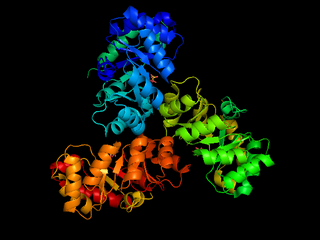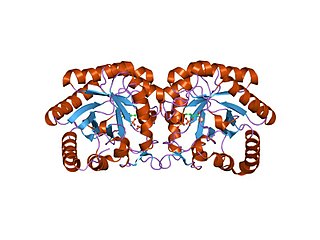| 2-dehydro-3-deoxy-6-phosphogalactonate aldolase | |||||||||
|---|---|---|---|---|---|---|---|---|---|
| Identifiers | |||||||||
| EC no. | 4.1.2.21 | ||||||||
| CAS no. | 9030-99-3 | ||||||||
| Databases | |||||||||
| IntEnz | IntEnz view | ||||||||
| BRENDA | BRENDA entry | ||||||||
| ExPASy | NiceZyme view | ||||||||
| KEGG | KEGG entry | ||||||||
| MetaCyc | metabolic pathway | ||||||||
| PRIAM | profile | ||||||||
| PDB structures | RCSB PDB PDBe PDBsum | ||||||||
| Gene Ontology | AmiGO / QuickGO | ||||||||
| |||||||||
The enzyme 2-dehydro-3-deoxy-6-phosphogalactonate aldolase (EC 4.1.2.21) catalyzes the chemical reaction
- 2-dehydro-3-deoxy-D-galactonate 6-phosphate pyruvate + D-glyceraldehyde 3-phosphate
This enzyme belongs to the family of lyases, specifically the aldehyde-lyases, which cleave carbon-carbon bonds. The systematic name of this enzyme class is 2-dehydro-3-deoxy-D-galactonate-6-phosphate D-glyceraldehyde-3-phosphate-lyase (pyruvate-forming). Other names in common use include 6-phospho-2-keto-3-deoxygalactonate aldolase, phospho-2-keto-3-deoxygalactonate aldolase, 2-keto-3-deoxy-6-phosphogalactonic aldolase, phospho-2-keto-3-deoxygalactonic aldolase, 2-keto-3-deoxy-6-phosphogalactonic acid aldolase, (KDPGal)aldolase, 2-dehydro-3-deoxy-D-galactonate-6-phosphate, and D-glyceraldehyde-3-phosphate-lyase. This enzyme participates in galactose metabolism.







